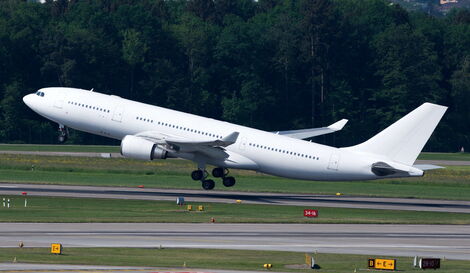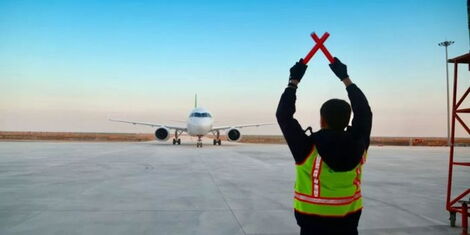Ever wondered why a pilot may decide to dump fuel in the sky minutes before landing? The aviation term for this is called fuel jettison.
Experts in the field term this rare occurrence as a situation when a pilot is necessitated to make an emergency landing.
The dumped fuel is depicted by a stream of white liquid as it disperses into a wide area.

An aeroplane has a Maximum Landing Weight (MLW), which dictates how heavy the aircraft should be when it lands. In most cases, the weight ought to be lower than the Maximum Takeoff Weight (MTOW).
Speaking to Kenyans.co.ke, Kenya Airways Director of Communications, Dennis Kashero, revealed that it is part of the regulatory requirement and does not endanger the passengers’ lives.
“In the case of the plane dumping fuel, it is a regulatory requirement to ensure the weight of the aircraft passes the standards,” he stated.
To guarantee safety, the pilot flicks a switch in the cockpit, which pumps the fuel out of the nozzles in the wings. This leads to the fuel dispersing in the sky to allow the particles to evaporate into a fine mist.
Aviation fuels primarily consist of hydrocarbon compounds such as paraffin and cycloparaffins.
What happens to the dumped fuel?
Its content enables the dumped fuel to begin evaporating before it reaches the ground. In particular, it’s dispersed over a wide enough area to enable the particles to evaporate into a fine mist.
If an aircraft is at a low altitude and disperses fuel, the fuel maintains its liquid form until it hits the ground.
According to international laws from the Federal Aviation Administration (FAA), fuel jettison should not occur when an aircraft is under 2,000 feet.
Pilots are also instructed in the regulations to dump fuel away from populated areas to avoid tragedy.
Which aircraft can dump fuel?
When a plane is to land urgently, the pilot determines if the fuel onboard will hinder the landing operations. However, not every aircraft can dump fuel.
In the case of smaller aeroplanes, the fuel onboard will not affect the aircraft’s emergency landing operations. Larger aeroplanes, on the other hand, have fuel jettison systems that allow for fuel to be dumped.
What happens if the aircraft attempts to land without dumping fuel first?
The risk is considered an overweight landing attempt and could place immense stress on the airframe of the aircraft.
This also escalates the chances of fire occurrence as well as fuel leakage onto the tarmac.

Source: kENYANS.CO.KE











